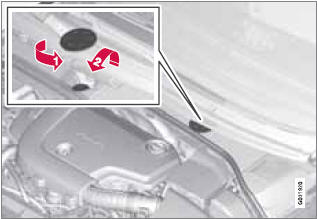Brake fluid


Location of the brake fluid reservoir
Checking the level
The fluid reservoir is concealed under the round cover at the rear of the engine compartment.
The round cover must be removed first before the reservoir cap can be accessed.
The brake fluid should always be between the MIN and MAX marks on the inside of the reservoir.
Check, without removing the cap, that there is sufficient fluid in the reservoir.
Fluid type: DOT 4+ boiling point >536 ∞F (280 ∞C), P/N 9437433
Replace: The fluid should be replaced according to the intervals specified in the Warranty and Service Records Information booklet.
When driving under extremely hard conditions (mountain driving, etc), it may be necessary to replace the fluid more often. Consult a trained and qualified Volvo service technician.
Always entrust brake fluid changing to a trained and qualified Volvo service technician.
WARNING
Х If the fluid level is below the MIN mark
in the reservoir or if a brake-related
message is shown in the information
display: DO NOT DRIVE. Have the car
towed to a trained and qualified Volvo
service technician and have the brake
system inspected.
Х Dot 4+ should never be mixed with any
other type of brake fluid.
Filling
1. Turn and open the cover.
2. Unscrew the reservoir cap and fill the fluid.
The level must be between the MIN and MAX marks.
See also:
Vehicle Overview
Volvo's small wagon, the V50, comes in 2.4i and T5 trim levels, the latter
offered in all- as well as front-wheel drive. A few years past a full redesign,
the V50 and its S40 sedan sister have bee ...
Cleaning the brake discs
Coatings of dirt and water on the brake discs may result in delayed brake function.
This delay is minimized by cleaning the brake linings.
Cleaning the brake pads is advisable in wet weather, prior ...
A/C Ц ON/OFF
When the indicator light in the
button is on, the air conditioning
is controlled automatically.
This cools/heats and
dehumidifies the incoming air.
When the indicator light in the
button i ...
